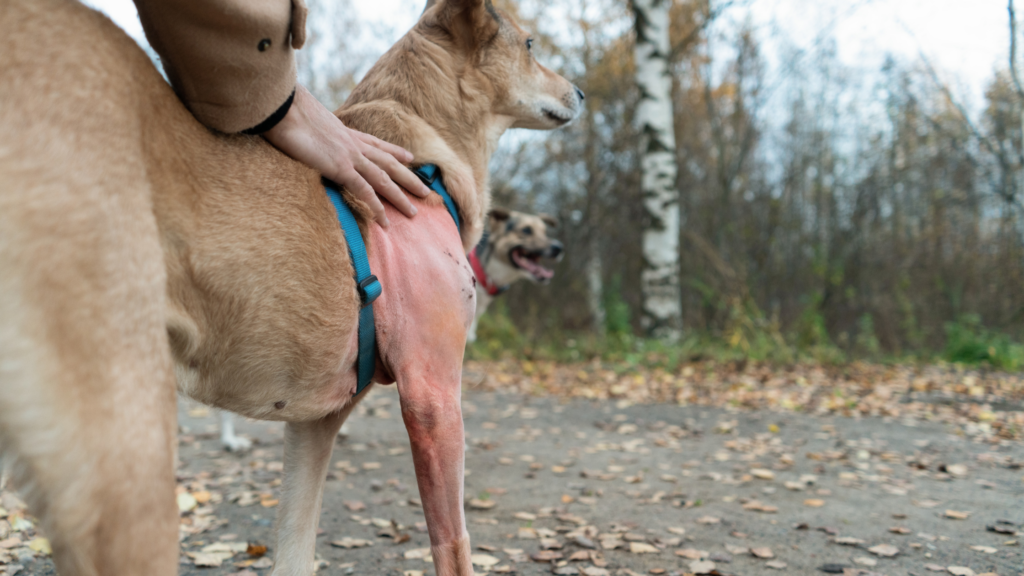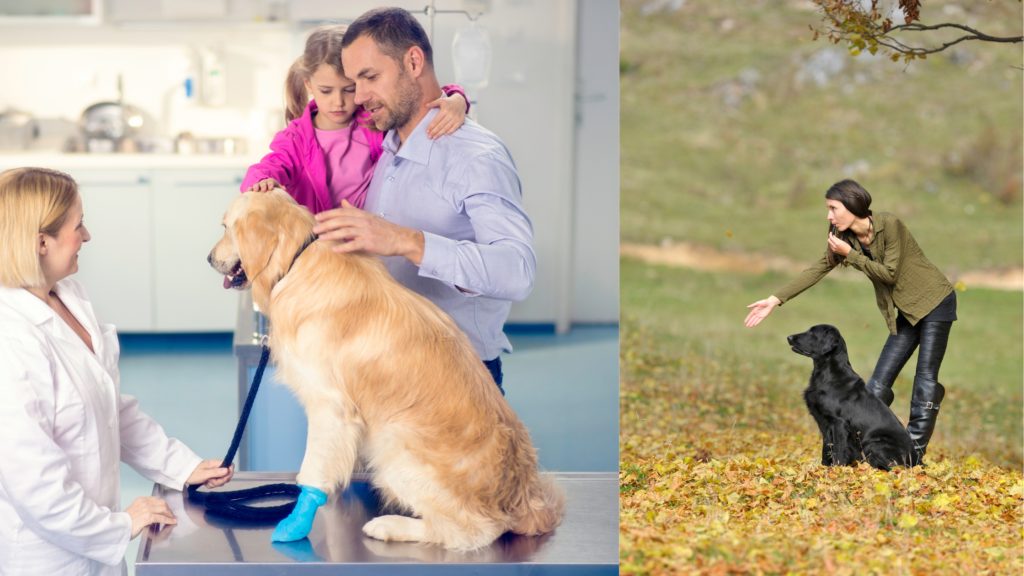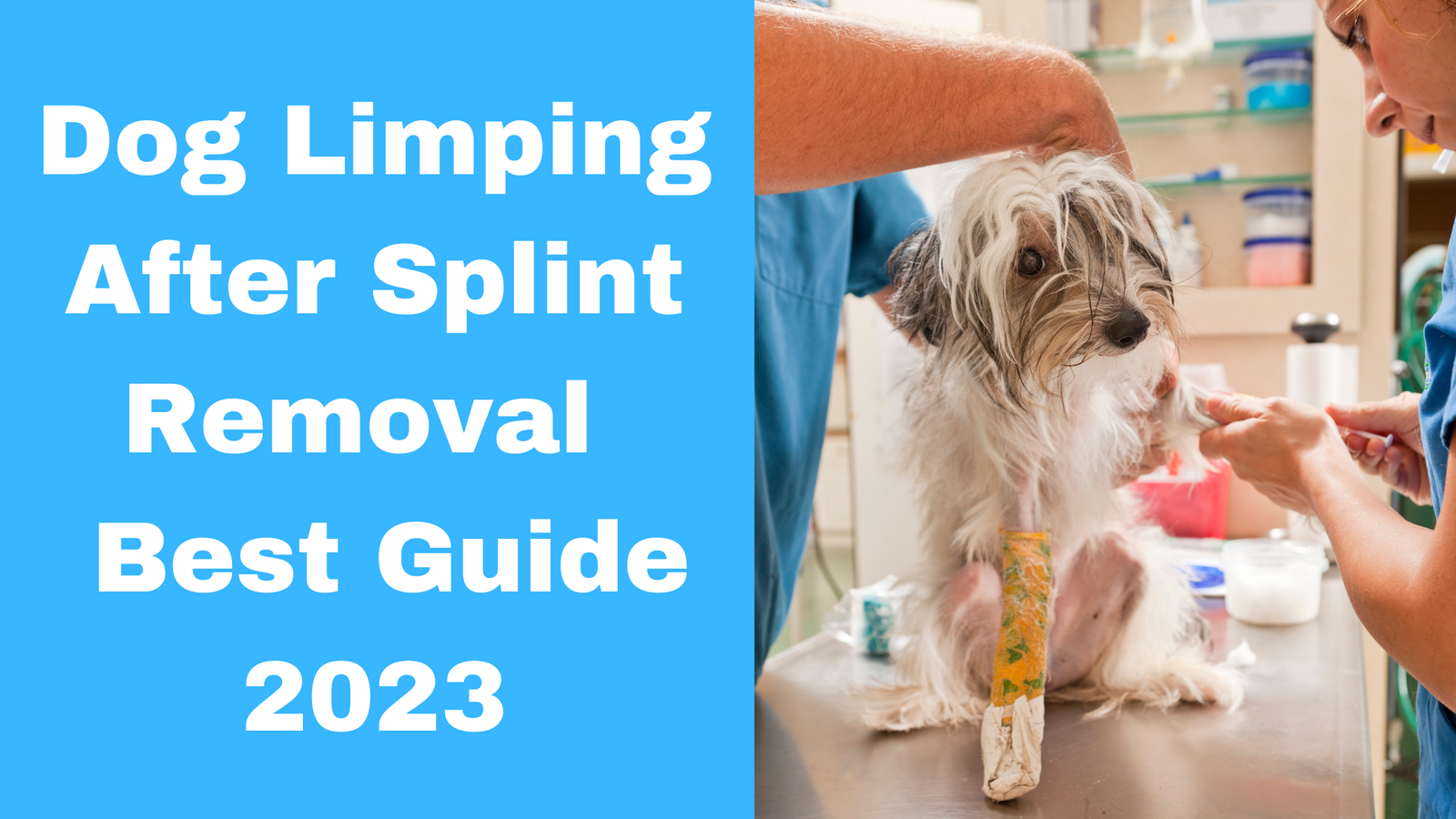Welcome to the world of doggy recovery! Seeing your Dog limping after splint removal can be concerning.
But fret not because we’re here to guide you through the process and provide valuable insights on how to help your dog during this phase.
This article delves into dogs limping after splint removal, focusing on recovery and post-splinting care.
We’ll address common questions and concerns that pet owners often have when their dog’s leg is no longer immobilized.
We aim to equip you with the knowledge and understanding needed to support your dog’s healing journey effectively.
We’ll explore various aspects, including the duration of limping, post-splinting care guidelines, reasons why dogs may continue to limp, signs of infection to watch out for, and when to seek veterinary care.
Additionally, we’ll provide insights into promoting healing and muscle building, as well as potential complications and risks.
By the end of this article, you’ll have a comprehensive understanding of the recovery process and the necessary steps to ensure your dog’s well-being.
So, let’s embark on this informative and exciting journey together, helping our furry friends bounce back on their paws with confidence and comfort!
Understanding the Recovery Process

Have you ever wondered how long your beloved pup might continue to limp after a broken leg and the subsequent splint removal?
Let’s dive into the fascinating world of doggy recovery and explore the ins and outs of the healing process.
How long will my dog limp after a broken leg?
First and foremost, it’s important to note that the duration of limping can vary from dog to dog.
The recovery timeline depends on several factors, such as the fracture’s severity, the break’s location, and your dog’s individual healing capabilities.
While some dogs may stop limping relatively quickly, others require more time and patience.
On average, it’s common for dogs to experience some degree of limping for a few weeks to a couple of months after a broken leg and splint removal.
However, it’s essential to remember that each case is unique, and your veterinarian will provide you with more specific information based on your dog’s condition.
During recovery, you might notice that your dog’s limping gradually improves over time.
Your furry friend will restore mobility and confidence as the bone heals and the muscles regain strength.
Patience and consistent post-splinting care are critical factors in supporting your dog’s recovery journey.
Remember, if you have any concerns about the duration or progress of your dog’s limping, don’t hesitate to contact your veterinarian.
They can provide personalized guidance and address any additional questions you may have.
Together, we’ll help your furry friend get back on all four paws and enjoy their adventurous life to the fullest!
Post-Splinting Care for dogs
Congratulations on reaching the post-splinting phase of your dog’s recovery! Now, it’s time to focus on the essential steps and precautions that will aid your furry friend in fully regaining their strength and mobility.
How long should a dog wear a splint?
First and foremost, the duration of time your dog needs to wear a splint will depend on the advice and guidance of your veterinarian.
Generally, dogs wear splints for several weeks to a few months. However, following your vet’s instructions diligently is crucial to ensure optimal healing and minimize the risk of re-injury.
Once the splint is removed, providing your dog with a safe and comfortable environment is essential. Limit their physical activity and avoid strenuous exercise that could strain the healing leg.
Additionally, prevent them from jumping or engaging in rough play that might compromise recovery.
Your veterinarian may recommend specific exercises or activities to support your dog’s rehabilitation.
These can include controlled walks, gentle stretching, and low-impact exercises to strengthen the muscles surrounding the previously injured leg gradually.
Always consult your vet before implementing any exercise regimen to ensure it suits your dog’s unique situation.
Keep a close eye on your furry companion during the recovery period. Watch for any discomfort, excessive swelling, or redness around the leg.
These could indicate a potential problem, such as infection or improper healing. If you notice any concerning symptoms, don’t hesitate to contact your veterinarian for further guidance.
Remember, the road to recovery requires patience and consistency. Provide your dog with plenty of love, care, and encouragement throughout the process.
With proper post-splinting care and rehabilitation, your four-legged friend will soon be back on their feet, ready to embark on new adventures together!
Dog Limping After Splint Removal
Ah, the curious case of the limping dog after splint removal! It’s common for our furry companions to continue limping even once the splint has been removed.
But fear not, for there are several reasons why this might occur.
Why is my dog limping after splint removal?
Firstly, it’s important to remember that the healing process takes time.
After a broken leg, the affected muscles, tendons, and ligaments may have weakened or become stiff due to inactivity during splinting.
This can lead to a temporary imbalance in your dog’s gait, causing them to limp as they readjust to using the leg again.
Additionally, residual pain and discomfort can contribute to continued limping.
While the splint may have provided support and stability, some pain persists. Just like humans, dogs may instinctively favor the injured leg to alleviate any lingering discomfort.
Muscle weakness is another factor to consider. When a leg is immobilized for an extended period, the muscles surrounding it may undergo atrophy or become weaker.
As a result, your dog may experience difficulty fully bearing weight on the previously injured limb, leading to a noticeable limp.
Fortunately, in most cases, these post-splinting limps resolve gradually over time as your dog regains strength, flexibility, and confidence in their recovering leg.
However, if the limping persists or worsens, or you notice any concerning signs such as swelling or increased pain, you must consult your veterinarian for a thorough evaluation.
Remember, each dog’s recovery is unique, and the duration and intensity of limping can vary.
Patience, gentle exercise, and consistent post-splinting care will go a long way in helping your furry friend regain full mobility.
Before you know it, they’ll be bounding around with their trademark enthusiasm, leaving that post-splinting limp far behind!
Also Read : Can Dogs Eat Plantain Chips? The Benefits & Risks – 2023
Average Recovery Time and Signs of Infection
Ah, the eagerly awaited recovery period after splint removal! While every dog’s healing journey is unique, there are some general guidelines and signs to remember.
What is the average recovery time for a dog after splint removal?
Firstly, let’s talk about the average recovery time. After the splint is removed, your furry friend usually takes a few weeks to regain their full strength and mobility.
However, please note that this can vary depending on the severity of the initial injury, your dog’s overall health, and its healing process.
Patience is critical during this phase, as it takes time for the muscles, tendons, and ligaments to regain strength and flexibility.
What are the signs of infection after splint removal?
Now, let’s turn our attention to signs of infection. It’s essential to closely monitor your dog’s leg for any red flags indicating an infection.
These can include swelling, redness, discharge, or excessive licking of the area. If you notice any of these symptoms, it’s crucial to consult your veterinarian promptly.
Infections can impede healing and lead to further complications if left untreated.
Your vet will be able to examine the leg, provide appropriate treatment, and help ensure a smooth recovery for your furry friend.
Remember, open communication with your veterinarian is essential during this phase.
They can provide specific guidance tailored to your dog’s needs and monitor their progress closely.
With proper care, attention, and a watchful eye for signs of infection, your loyal companion will return to their paws quickly!
Seeking Veterinary Care
Ah, the role of the vigilant pet parent continues even after the splint is removed! While most dogs recover smoothly, there are instances where seeking veterinary care is crucial to ensure your furry friend’s well-being.
When should I take my dog back to the vet?
So, when should you take your dog back to the vet? Well, there are a few situations that warrant immediate veterinary attention.
If your dog experiences sudden and severe pain or excessive swelling or limping worsens significantly, it’s time to pick up the phone and schedule a visit to the vet.
These could be signs of complications or underlying issues that require professional evaluation.
Additionally, if you notice any concerning changes in your dog’s behavior, such as decreased appetite, lethargy, or unusual discharge from the leg, you must consult your veterinarian promptly.
Our four-legged companions can’t vocalize their discomfort, so we must be their advocates and address potential problems.
Remember, your veterinarian is your trusted partner in your dog’s recovery journey.
They have the knowledge and expertise to assess your dog’s condition, conduct necessary tests or examinations, and provide appropriate treatment or interventions.
It’s always better to err on the side of caution regarding your precious pup’s health. If you have any doubts or concerns during recovery, don’t hesitate to contact your veterinarian.
They’ll be able to guide you and ensure your dog receives the best care possible, bringing them one step closer to a happy and healthy life on all four paws.
Promoting Healing and Muscle Building

Promoting healing and muscle building in the splinted leg becomes crucial as your dog continues on their road to recovery.
But how can you assist your furry friend in regaining strength and mobility? Let’s explore some tips and exercises to aid in their rehabilitation journey.
How can I help my dog build up muscle in his splinted leg?
First and foremost, it’s essential to consult your veterinarian or a veterinary rehabilitation specialist before initiating any exercises.
They can provide specific guidance tailored to your dog’s condition and recovery progress.
What exercises can I do to help him recover?
Controlled physical activity is critical to helping your dog build muscle in the splinted leg.
Start with gentle exercises such as controlled leash walks or short, supervised sessions of low-impact movements.
These activities encourage your dog to use the leg, gradually promoting muscle strength without causing undue stress or strain.
Another beneficial exercise is range-of-motion exercises, which involve gently flexing and extending the joints of the splinted leg.
Your veterinarian or a professional rehabilitation therapist can demonstrate these exercises and guide you in performing them safely. These exercises help maintain joint flexibility and prevent stiffness.
Additionally, rehabilitation tools such as balance boards or physiotherapy balls can strengthen muscles.
These tools challenge your dog’s balance and engage the powers of the splinted leg as they maintain stability.
However, using these tools under professional guidance is crucial to ensure proper technique and prevent injury.
Remember, consistency and patience are key during your dog’s recovery process.
Gradually increase the duration and intensity of exercises as guided by your veterinarian. Constantly monitor your dog’s comfort level and adjust the activities accordingly.
Remember that every dog’s recovery journey is unique, and the rehabilitation process may vary.
Your veterinarian or a rehabilitation specialist can provide personalized recommendations based on your dog’s condition, age, and overall health.
By providing targeted exercises and promoting gradual muscle building, you’ll be helping your canine companion regain strength and mobility in their splinted leg.
Together, you’ll work towards a successful recovery and a wagging tail that signals your restored zest for life!
Complications and Risks
While we hope for a smooth and uneventful recovery after splint removal, there can be instances where complications arise.
It’s essential to be aware of the signs that indicate a dog’s leg may not be healing properly and the potential risks involved.
By staying vigilant, you can take the necessary steps to address any issues that may arise.
What are the signs of a dog’s leg not healing correctly?
Signs that a dog’s leg may not heal correctly include persistent or worsening limping, swelling, or discomfort.
If you notice your dog favoring the previously splinted leg, experiencing persistent lameness, or showing signs of pain, it could indicate an issue with the healing process.
Other symptoms to watch for include open wounds, discharge, or a noticeable change in the appearance of the leg.
If you observe any of these signs, it’s essential to consult your veterinarian promptly.
What are the risks of complications after splint removal?
Complications after splint removal can vary depending on the nature of the original injury, the effectiveness of the treatment, and individual factors.
Some common complications may include delayed or incomplete bone healing, infection, or the development of abnormal bone formations.
These complications can prolong the recovery process and may require additional medical intervention.
The risks associated with complications after splint removal emphasize the importance of post-splinting care and regular monitoring.
If left untreated, complications can lead to chronic pain, further damage to the affected leg, and potentially impact your dog’s overall quality of life.
Timely intervention and veterinary guidance are essential to address complications and ensure proper healing.
If you have concerns about your dog’s recovery or suspect that the leg may not be healing as expected, it’s crucial to contact your veterinarian.
They can assess the situation, perform diagnostic tests if necessary, and recommend appropriate treatment options to promote proper healing and address any complications.
Remember, each dog’s healing process is unique, and complications are not inevitable.
By closely monitoring your dog’s recovery, following post-splinting care guidelines, and seeking veterinary attention when needed, you can increase the chances of a successful and uneventful recovery.
Your proactive approach will contribute to your furry friend’s well-being and their return to a happy, active life.
Also Read : Can You Burn Dog Poop? Exploring Safe Disposal Methods
Conclusion
In conclusion, a dog’s recovery journey after splint removal requires patience, diligence, and proper post-splinting care.
We’ve explored various aspects of this process, from understanding the duration of limping to promoting muscle strength and monitoring for signs of infection or complications.
Remember, each dog’s recovery timeline may vary, and patience’s essential as they regain their strength and mobility.
Adhering to the guidelines provided by your veterinarian and following a gradual approach to physical activity will contribute to a smoother recovery.
Vigilance is vital when it comes to post-splinting care. Keep a close eye on your dog for any signs of infection, such as swelling, redness, discharge, or excessive licking.
If you notice these signs, promptly consult your veterinarian for appropriate treatment.
We’ve also discussed the importance of seeking veterinary care when needed.
Don’t hesitate to contact your veterinarian if you have concerns or observe any abnormalities during your dog’s recovery.
They can provide personalized guidance and support based on your dog’s situation.
Your role as a responsible and attentive pet owner is crucial in this process.
By providing the necessary care, monitoring for any changes, and working closely with your veterinarian, you can help ensure a successful recovery for your furry friend.
Remember, your veterinarian is your trusted partner throughout this journey. They have the expertise and knowledge to address any concerns, provide tailored advice, and offer reassurance during recovery.
So, stay proactive, be patient, and remember to celebrate each milestone your dog achieves. With proper care and support, they will soon be back on their feet, ready to enjoy life’s adventures again.
